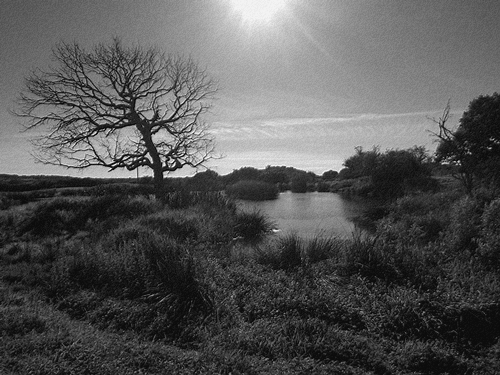°Arcus°
Home » Spooky Lancashire » Jenny Greenteeth
THE LURKER IN THE WATER - JENNY GREENTEETH AND HER KINDRED

To this end, stories arose around a variety of figures - Bloody Bones, the Grindylow (who cannot but remind us of Beowulf's enemy Grendel and his fearsome, water-dwelling mother) - who lurked beneath the thin, gleaming, promising, inviting surface of these bodies of water, waiting patiently, silently, not moving even a muscle, for a poor unsuspecting child to stray within their grasp. Reports of children drowning would be passed off as the dread "Jenny Greenteeth" about her work, and would serve as a stark reminder to those yet living that by but a thin thread hung their lives, with peril lurking all around.
This Jenny Greenteeth, taking her name perhaps from the colour of the duckweed which is wont to grow within these places, is the most abiding name we have for these pond-lurkers, akin to the nixies of Germanic lore and other such spirits. Jenny is to be found all across the County Palatine & beyond, under a variety of variations and guises, but ever skulking in the murky shallows of treacherous pools.
Thus, perhaps it is prudent to heed the warning: "beware Jenny Greenteeth & her kindred, lest they lead thee to a watery doom."
JENNIFER GRETCHLEY - A POSSIBLE BACKSTORY?
S.D. Tucker provides an account of the story of Jenny from the Warrington area. Apparently, during the 1790s, a "horrible old hag" by the name of Jennifer Gretchley supposedly dwelt on "a barren and desolate smallholding" in the vicinity of Moore Lane, into which she would lure itinerants with the promise of hospitality, before strangling them and slicing them up into small chunks which she then disposed of in a small tarn overgrown with weeds in the area known as "The Three-Cornered Pit," where, at some point, local children, making use the spot to find tadpoles, made the gruesome discovery of parts of one of Gretchley's most recent victims.
Suspicion immediately fell on this reclusive old beldam, and attempts were made to apprehend her at her home. Gretchley, however, was not there, though bundles of cloth indicated that they were correct in their assumptions of her guilt.
Nothing more would be heard of Jennifer Gretchley for some 40 years, at which point a local farmer remarked upon her ghost, standing atop the weeds in the pool, beckoning him to join her in the deep waters beneath. This apparition reappeared for many years afterwards, leading to speculation that the pond was bottomless and ensuring that the local children were too terrified to go near it. Some time later, two men working nearby uncovered the skeletal remains of a woman nearby, which were taken to belong to Gretchley. The last recorded sighting of her spectre occurred not long before 1937, during which year the Three-Cornered Pit was filled in and a box factory erected on the spot.

THE GRINDYLOW
Another name associated with this particular faerie or demonic entity - and one with hoary mythic overtones - is the Grindylow. John Higson, a local historian and collector of the folklore of the Tameside area, notes that: -
William Canton, in the 16th chapter of his tale Seventeen-Fifteen, A Story of the Rebellion, interweaves snippets of folklore into his romantic framework. One of these snippets involves the Grindylow - "a parlous water devil with great, green teeth" - which appears in a relation by one "Black Kirkham," a brooding figure who has set up base at Peel in Marton, about the tragic demise of one Jessie BreckalJessie Breckal, with her illegitimate offspring, is apparently based upon the real-life Jane Breckal (or Breckul) of Poulton, the last girl to undergo public penance for conceiving out of wedlock at some point between 1770 and 1810., the mother of another of Canton's characters, the "White Tullet."
According to Canton, the flowers which appeared on the surface of old ponds and marl-pits are "Grindylow's green hat," and anyone endeavouring to pluck a bunch finds the monster's "long sinewy arms lurking under water" and "clutched their little hands and dragged them under, and a spout of blood has shot up from the surface and all was over."
In the case of the unfortunate Miss Breckal, the story goes that, having been humiliated at Poulton church, "in a white sheet, a lighted candle in each hand," she vanished amidst strange portents: -
THE DEMONIC CHILDREN OF CAIN
Both Grendel and his mother are associated with liminal areas, defined as moors and, more relevantly, fens. These were the domain of the "other," in this instance the monstrous offspring of the Biblical Cain - eotenas ond ylfe ond orcneas, swylce gīgantas, þā wið Gode wunnon [112-113] - whose status as murky figures lurking in the gloaming beyond the centres of human activity marks them out as something to be feared and conquered. For example, when he has been mortally wounded by the eponymous hero, Grendel retreats to his fenfreoðo, his "fenland haven." Similarly, Grendel's mother, who seeks to avenge him and is in turn defeated and killed by Beowulf, is associated with water, albeit in this instance it is the sea. In one famous scene, Beowulf must descend to the benthic lair of this powerful female monster in order to put an end to her quest for vengeance.
